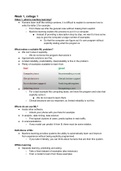Samenvatting
Summary of the course machine learning, second year AI bachelor at the VU.
- Instelling
- Vrije Universiteit Amsterdam (VU)
This document provides a relatively extensive summary of the machine learning course, given in the second year of the AI bachelor. It covers all video's used as lecture material in the year , during the COVID breakout.
[Meer zien]




